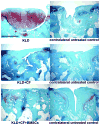Effect of self-assembling peptide, chondrogenic factors, and bone marrow-derived stromal cells on osteochondral repair
- PMID: 20851201
- PMCID: PMC3257023
- DOI: 10.1016/j.joca.2010.09.004
Effect of self-assembling peptide, chondrogenic factors, and bone marrow-derived stromal cells on osteochondral repair
Abstract
Objective: The goal of this study was to test the ability of an injectable self-assembling peptide (KLD) hydrogel with or without chondrogenic factors (CF) and allogeneic bone marrow stromal cells (BMSCs) to stimulate cartilage regeneration in a full-thickness, critically-sized, rabbit cartilage defect model in vivo. We used CF treatments to test the hypotheses that CF would stimulate chondrogenesis and matrix production by cells migrating into acellular KLD (KLD+CF) or by BMSCs delivered in KLD (KLD+CF+BMSCs).
Design: Three groups were tested against contralateral untreated controls: KLD, KLD+CF, and KLD+CF+BMSCs, n=6-7. Transforming growth factor-β1 (TGF-β1), dexamethasone, and insulin-like growth factor-1 (IGF-1) were used as CF pre-mixed with KLD and BMSCs before injection. Evaluations included gross, histological, immunohistochemical and radiographic analyses.
Results: KLD without CF or BMSCs showed the greatest repair after 12 weeks with significantly higher Safranin-O, collagen II immunostaining, and cumulative histology scores than untreated contralateral controls. KLD+CF resulted in significantly higher aggrecan immunostaining than untreated contralateral controls. Including allogeneic BMSCs+CF markedly reduced the quality of repair and increased osteophyte formation compared to KLD-alone.
Conclusions: These data show that KLD can fill full-thickness osteochondral defects in situ and improve cartilage repair as shown by Safranin-O, collagen II immunostaining, and cumulative histology. In this small animal model, the full-thickness critically-sized defect provided access to the marrow, similar in concept to abrasion arthroplasty or spongialization in large animal models, and suggests that combining KLD with these techniques may improve current practice.
Copyright © 2010 Osteoarthritis Research Society International. Published by Elsevier Ltd. All rights reserved.
Conflict of interest statement
Figures


Similar articles
-
Controlled delivery of transforming growth factor β1 by self-assembling peptide hydrogels induces chondrogenesis of bone marrow stromal cells and modulates Smad2/3 signaling.Tissue Eng Part A. 2011 Jan;17(1-2):83-92. doi: 10.1089/ten.TEA.2010.0198. Epub 2010 Sep 22. Tissue Eng Part A. 2011. PMID: 20672992 Free PMC article.
-
Articular Cartilage Repair with Mesenchymal Stem Cells After Chondrogenic Priming: A Pilot Study.Tissue Eng Part A. 2018 May;24(9-10):761-774. doi: 10.1089/ten.TEA.2017.0235. Epub 2017 Nov 30. Tissue Eng Part A. 2018. PMID: 28982297
-
Demineralized bone matrix combined bone marrow mesenchymal stem cells, bone morphogenetic protein-2 and transforming growth factor-β3 gene promoted pig cartilage defect repair.PLoS One. 2014 Dec 29;9(12):e116061. doi: 10.1371/journal.pone.0116061. eCollection 2014. PLoS One. 2014. PMID: 25545777 Free PMC article.
-
Chondrogenic differentiation of ChM-I gene transfected rat bone marrow-derived mesenchymal stem cells on 3-dimensional poly (L-lactic acid) scaffold for cartilage engineering.Cell Biol Int. 2015 Mar;39(3):300-9. doi: 10.1002/cbin.10393. Epub 2014 Dec 17. Cell Biol Int. 2015. PMID: 25319137
-
Quality of Cartilage Repair from Marrow Stimulation Correlates with Cell Number, Clonogenic, Chondrogenic, and Matrix Production Potential of Underlying Bone Marrow Stromal Cells in a Rabbit Model.Cartilage. 2021 Apr;12(2):237-250. doi: 10.1177/1947603518812555. Epub 2018 Dec 20. Cartilage. 2021. PMID: 30569762 Free PMC article.
Cited by
-
Effect of insulin-like growth factor-1 and hyaluronic acid in experimentally produced osteochondral defects in rats.Indian J Orthop. 2016 Jul-Aug;50(4):414-20. doi: 10.4103/0019-5413.185607. Indian J Orthop. 2016. PMID: 27512224 Free PMC article.
-
Enzyme Pretreatment plus Locally Delivered HB-IGF-1 Stimulate Integrative Cartilage Repair In Vitro.Tissue Eng Part A. 2019 Sep;25(17-18):1191-1201. doi: 10.1089/ten.TEA.2019.0013. Epub 2019 Sep 3. Tissue Eng Part A. 2019. PMID: 31237484 Free PMC article.
-
Trypsin Pre-Treatment Combined With Growth Factor Functionalized Self-Assembling Peptide Hydrogel Improves Cartilage Repair in Rabbit Model.J Orthop Res. 2019 Nov;37(11):2307-2315. doi: 10.1002/jor.24414. Epub 2019 Aug 6. J Orthop Res. 2019. PMID: 31318103 Free PMC article.
-
Effects of the combination of microfracture and self-assembling Peptide filling on the repair of a clinically relevant trochlear defect in an equine model.J Bone Joint Surg Am. 2014 Oct 1;96(19):1601-9. doi: 10.2106/JBJS.M.01408. J Bone Joint Surg Am. 2014. PMID: 25274785 Free PMC article.
-
Repair of full-thickness articular cartilage defects using IEIK13 self-assembling peptide hydrogel in a non-human primate model.Sci Rep. 2021 Feb 25;11(1):4560. doi: 10.1038/s41598-021-83208-x. Sci Rep. 2021. PMID: 33633122 Free PMC article.
References
-
- Getgood A, Brooks R, Fortier L, Rushton N. Articular cartilage tissue engineering. J Bone Joint Surg Br. 2009;91-B:565–576. - PubMed
-
- Hoemann C, Sun J, McKee M, Chevrier A, Rossomacha E, Rivard G-E, et al. Chitosan-glycerol phosphate/blood implants elicit hyaline cartilage repair integrated with porous subchondral bone in microdrilled rabbit defects. Osteoarthritis and Cartilage. 2007;15:78–89. - PubMed
-
- Nixon A, Fortier L, Williams J, Mohammed H. Enhanced repair of extensive articular defects by insulin-like growth factor-I-laden fibrin composites. J Orthop Res. 1999;17:475–487. - PubMed
-
- Wegener B, Schrimpf F, Pietschmann M, Milz S, Berger-Lohr M, Bergschmidt P, et al. Matrix-guided cartilage regeneration in chondral defects. Biotechnol Appl Biochem. 2009;53:63–70. - PubMed
Publication types
MeSH terms
Substances
Grants and funding
LinkOut - more resources
Full Text Sources
Other Literature Sources
Miscellaneous

